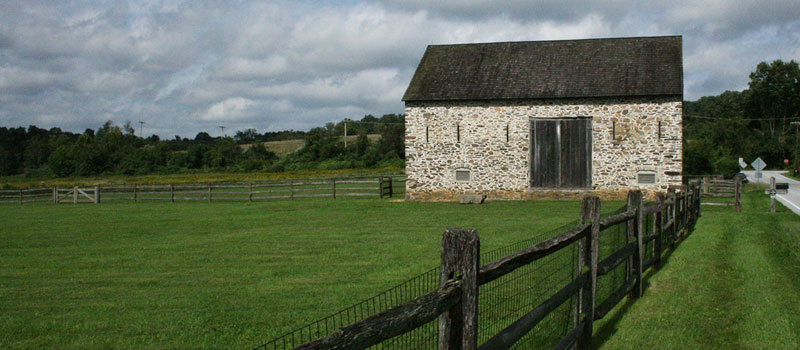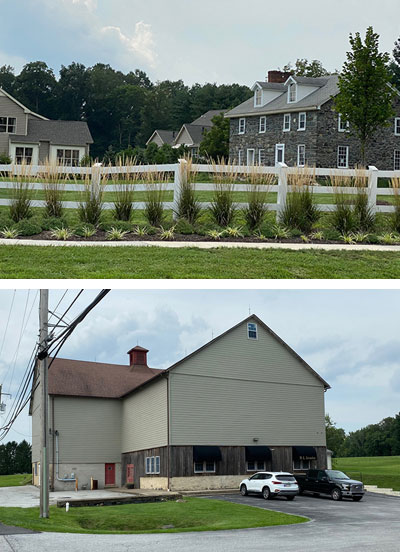The historic farm house (top) was protected via Kennett Township's zoning regulations and land development review process and the barn (bottom) had been parceled off prior to the current development.
How it Works
Historic resources are valued, ingrained elements in many communities, and yet their protection and continuation into the future is often not guaranteed. Historic resource protection standards provide protection to such historic resources, maintaining them as cornerstones of community identity and sense of place within the evolving cultural landscape.
Historic resource protection standards support municipal preservation planning policy. The standards can be included in zoning ordinances, subdivision and land development ordinances, and/or local historic district ordinances. Regulations can vary depending on such factors as historic resource types and their context, local policies, and other considerations.
Two Pennsylvania enabling acts provide the legal basis for municipalities to protect historic resources with standards:
Act 247 of 1968
Municipalities Planning Code (MPC) allows historic resources protection using local land use and planning controls. Ordinances are developed and administered at the local level and often with advisory assistance of a municipal Historical Commission that is created under the Township or Borough Code.
In Chester County, municipal historic resource protection regulations are often MPC-based through zoning and subdivision and development provisions. Provisions can address resource identification criteria, impacts and limitations of new proposals on resources, demolitions, rehabilitations, area and bulk standards, and incentives to encourage resource preservation and reuse. Other MPC regulations, e.g. traditional neighborhood development and transfer of development rights, can also provide a level of historic resource protection. The MPC also provides for regional planning entities to address historic resources protection.
Act 167 of 1961
Historic District Act (HDA) allows municipalities to protect historic character in local historic districts. Local historic districts and standards are developed locally, districts are certified by Pennsylvania Historical and Museum Commission, and the standards are administered at the local level and with the assistance and review of a local Historic Architectural Review Board (HARB) that is created under the HDA. While MPC regulations largely focus on community character and land use-oriented protection measures, Act 167 regulations focus primarily on preserving the physical aspects of the historic built environment in a defined area.
In Chester County, HDA is often been applied to preserve the character, context, and architecture of concentrated historic areas in towns and villages, including existing structures and new construction. It has also been applied in lower density areas, e.g. rural historic districts, taking a thematic contextual form. HDAs have contributing and non-contributing elements, but all elements are taken into some level of account to maintain district character. HDAs are often incorrectly associated with requiring strict architectural and aesthetic design, e.g. color limitations; however, the enabling law is written broadly and allows flexibility and latitude in structuring local regulations that are appropriate for an individual municipality.
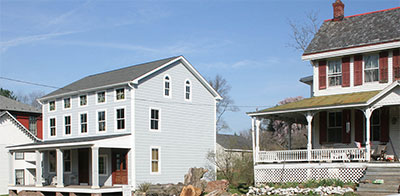
Historically-compatible newer home construction in Marshallton Village meets the scale, massing, and proportions of its context and surrounding historic buildings.
Benefits
Community Character
Protecting historic resources and their context, while allowing for compatible alterations and new development, helps maintain existing character for future generations and contributes to a community’s overall vitality and sense of place.
Community Choice
A variety of regulatory standards, including incentives for preserving historic resources, allows a municipality to create a set of regulations that best serves the community.
Economic Value
Protection standards can promote property maintenance, as well as rehabilitation and adaptive reuse. Owners may be eligible for federal or state tax credits for rehabilitation investments in older or historic buildings. Historic preservation can help property values and marketing for downtown business development.
Environmental Benefits
Retaining historic resources can contribute to energy conservation and smart growth by reusing existing building stock and infrastructure, remediating potential contaminants, preventing demolition and debris material directed to landfills, and continuing use of energy embodied in existing development.
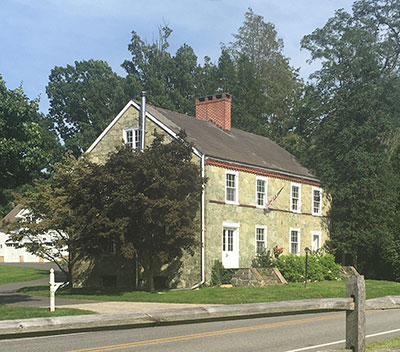
Preserved home in the Birmingham Road Corridor Local Historic District.
Get Started
Historic resource zoning and subdivision and land development regulations created under Act 247 and certified historic districts created under Act 167 are the most effective ways of protecting historic resources in Pennsylvania. Several municipalities in Chester County regulate historic resource protection standards in their ordinances. The following are general actions to take in developing local historic resource protection regulations:
Resource Identification
Like any other regulation, what is being regulated needs to be understood and identified. Resource identification should occur as a part of or be recommended by the municipal Comprehensive Plan. See Historic and Cultural Resource Preservation Planning eTool. There are different levels of resource identification for different planning functions, each yielding tabular and mapped information. Resource identification terminology applied in Chester County is as follows:
Atlas (or List) — a preliminary or "windshield" catalogue of all structures 50 years and older. It provides an overview of the extent and location of resources. The 50 year mark is the established federal benchmark for historic resources planning, but it is not meant to exclude consideration of newer resources, if appropriate.
Inventory — considers Atlas information to determine which resources to protect by regulations and other methods. As with other regulations, resource designation criteria are used, which provides clarity and objectivity. The Inventory table and/or map is incorporated into the regulations.
Survey — a more detailed analysis of the resources in an Atlas. It can provide architectural, site, history, and other information useful for building alteration reviews. In Chester County, often a Survey takes the form of an exterior architectural, site, and historic context analysis with property level history (e.g. deed research), occurring on a limited basis. Using PHMC (Pennsylvania Historical and Museum Commission) digital survey forms provides consistency of core information. PHMC has specific forms and guides for different types of surveys and should be contacted prior to ensure the correct forms are being used for the survey in question.
Community Participation — A community outreach process helps gather input on the appropriate type and extent of historic resource protection measures, as well as their application and implementation. It also creates a forum in which the community can continue to be involved and volunteer in historic resource planning. Municipal historic commissions or other similar entities can serve as community liaisons.
MPC or HDA
Consider whether MPC-based standards, HDA-based standards, or both types of standards are appropriate in the municipality. See "How It Works" and "Examples" for information to help with this determination.
Design Guidelines
Design guidelines assist municipal official, historical commission, and HARB reviews of historic building rehabilitations and alterations. Guidelines also assist in evaluating compatibility of new construction in historic settings and help property owners understand and comply with ordinance standards. A clear set of review criteria is essential.
In general, design guidelines should: include a common terminology to describe design items; define and compare present day character with the historic character that is to be maintained; and forecast future land use and development types based on market trends and community needs, and municipal policies.
Ordinance Standards Preparation
Whether MPC or HDA-based, preservation standards include core elements. Standards must define historic resources and areas to which they will apply through a historic resources inventory and map, and establish review processes, standards, or criteria used for resource identification, review, determination, enforcement, and reporting.
MPC-based standards may address historic resources on a municipal-wide basis, in a specific area, and/or may focus on specific types of resources as defined. Historic resource standards may include items such as adaptive reuse, incentives to encourage preservation and continued use of resources, impact of development on resources, structural alteration review, landscaping, lighting, or signage, and/or demolition.
Standards may apply a more limited protection approach, employing one or two of the above measures, or may apply a more holistic protection approach, employing all of the listed measures. Standards, whether holistic or more limited, may be placed in a zoning article with other municipal resources being protected, such as scenic or natural resources, may be in a separate historic resources standards article, or may be an overlay district. Historic resources located within proximity to one another may also be protected as part of base zoning districts, such as village or downtown districts.
HDA-based protection standards also use a district-based approach. While HDA resources are often located in a more compact area in proximity to one another, there are also rural HDA districts with historic resources dispersed over a larger area. Such standards focus more on architecture and physical character including provisions for and structural alterations, landscaping, lighting, fencing, signage, and/or demolition as well as district design guidelines.
Ordinance Standards Adoption
The MPC has specific requirements for adopting zoning, subdivision and land development ordinances. The adoption of HDA standards must follow the requirements of the Historic District Act, which are different from MPC requirements. Some municipalities adopt HDA standards into the zoning ordinance ease of use and consistency with other resource protection and land use standards.
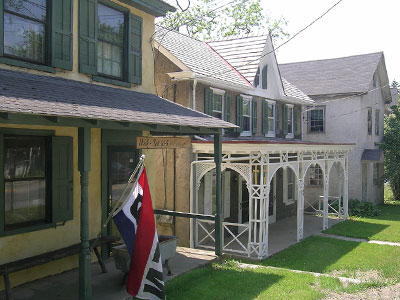
Preserved buildings in Guthriesville National Register Historic District.
Considerations
Consistent Terminology
Employing broadly accepted, well-defined, and consistent terminology, resource identification processes, and review criteria can help address concerns regarding the subjectivity of historic resource protection.
MPC and Act 167 Regulations Compatibility
When a municipality uses both MPC and HDA regulations for resource protection, both sets of regulations need to take one another into consideration and be complementary. As noted above, HDA regulations are sometimes placed in zoning for ease of use, although they are not adopted under the MPC.
Review Process
Interpretation of ordinance provisions and the application of design standards can be a regulatory and administrative challenge, particularly for new Historical Commission or HA RB members and continuously changing elected and appointed local officials. Adoption of clear regulatory provisions and processes, clear municipal administrative procedures and forms, and regular trainings can address this challenge.
Property Rights
As with other ordinance provisions, regulation of privately held property is often part of historic resource protection. Community education on the benefits of historic resource protection, an inclusive public process in developing standards, and a clear review process can help minimize conflicts.
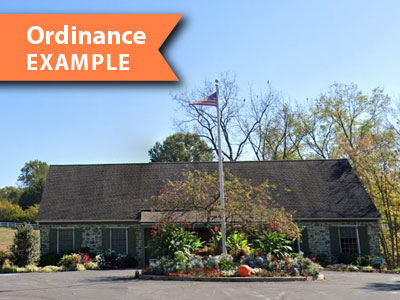
Examples
Birmingham Township is a Suburban and Rural Landscape with a Significant Historic Landscape Overlay. It has a HARB and Historical Commission. Historic resource protection standards are found in several zoning sections, e.g. Historic-Commercial zoning district, Historic zoning district overlay, and historic preservation standards, as well as in subdivision and land development regulations, an example of which is here. Dilworthtown village, located at one of the only remaining colonial-era five-point intersections in Chester County, still contains 18th and 19th century buildings and character. To preserve this village and the 18th century Birmingham Road/surrounding historic landscape, there are two local historic districts under a Historic District Protection Ordinance and design guidelines.

East Brandywine Township is in a Suburban Landscape with a Significant Historic Landscape Overlay. It has a Historical Commission. Historic resource protection regulations are found within the zoning and subdivision and land development ordinances. The historic village of Guthriesville is addressed through zoning regulations and design guidelines specific to village enhancement.

East Pikeland Township is in a Rural and Suburban Landscape with a Suburban Center and Significant Historic Landscape Overlay. It has a Historical Commission that includes the HARB. MPC-based and HDA-based historic resource protection standards are in the zoning ordinance. A Historic Property Review Form outlines information needed for Historical Commission and HARB review processes.

Pennsbury Township is in a Rural and Suburban Landscape with a Significant Historic Landscape Overlay. It has a Historical Commission. The zoning ordinance contains historic resource protection standards. It also includes a Route 1 Corridor and Brandywine Battlefield overlay that addresses rural cultural landscape and historic battlefield landscape protection.
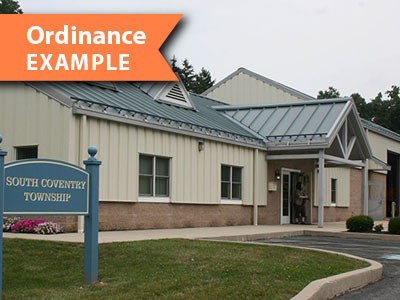
South Coventry Township is in an Agricultural and Rural Landscape with a Rural Center and Significant Historic Landscape Overlay. It has a combined Historical Commission and HARB. The zoning ordinance, on file at the Township Building, provides historic resource protection standards in a historic resource overlay and in village areas.

Thornbury Township is in a Suburban Landscape with a Significant Historic Landscape Overlay. It has a Historic Preservation Commission. The zoning ordinance contains historic resource preservation standards, and a Historic Battlefield zoning overlay to protect Revolutionary War battlefield sites.

West Chester Borough is an Urban Center with a HARB and Historical Commission. The Borough contains three National Register Historic Districts, one of which, the Downtown Historic District, is also a Local Historic District with design guidelines.

West Whiteland Township is in a Suburban Landscape with a Significant Historic Landscape Overlay. It has a Historical Commission. In the 1980s, the township developed and adopted the first MPC-based historic resource zoning protection measures in the Commonwealth, which then became a model approach that has been updated and revised based on individual municipal policy and resources. The township continues to value historic resources and their protection through zoning.


